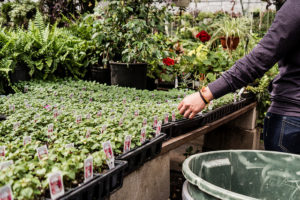This time of year the internet is awash with helpful articles about changing your habits in new years resolutions. The focus is usually on dieting and exercise advice. However, there are often other areas of your life you may wish to improve upon, make efficiencies in, or simply do better in. In this article I will share with your some New Year’s resolutions I think all gardeners would benefit from in 2017.
1. Plan your Garden Before you Buy

Central Campus Spring Plant Sale by Phil Roeder CC2.0
Sadly I see gardeners fall short on this one all the time. The intention is to revamp a small area of your garden, so you go to the garden centre and buy some new plants. However, all to often people don’t plan ahead, and actually have little idea of what plants they need to buy. Its really important to plan ahead and buy the plants you actually need, and not just the plants the garden centre manager wants you to buy. The benefits of this will be that you have the right plant for the right place, that suits your soil, aspect, spatial and maintenance requirements, and budget. Going to the garden centre without a clear idea of the plants you want to buy and where and how you are going to use them is like going to the superstore without a shopping list in your head, and just hoping you can make something with the ingredients you’ve bought. Sure you’ll have some nice food, but you might not be able to bake that cake you really wanted to make without any eggs.
The best solution to this, is to engage a professional garden designer who can come up with a planting plan, and often obtain plants at trade prices for you, saving you money over garden centre prices.
If this is really not possible for you, then you can make a plan of what you want to plant, and use the Royal Horticultural Society’s (RHS) handy plant finder to find where the plants are available in your local area.
2. Plan Before you Dig
Another good New Year’s resolution to make in the garden is to plan ahead before you dig. Often gardeners are keen to ‘get their hands dirty’ and jump straight into creating new boarders/planting areas, or enlarging existing ones. A little bit of planning can go along way in saving you time and money. I recommend thinking through your ideas before taking the spade out of the shed. What is it you are trying to achieve? Is it screening to hide an ugly sight? Are you hoping to create a more balanced scene? Are you hoping to create a sense of separation between areas? By thinking these things through before you start digging you are more likely to achieve your gardening goals. For example, what height do your new plants need to be to create that spatial definition, or screen that unpleasant sight? Also does the shape of your new area of planting fit with the form-language of the rest of your garden_ It can be difficult to reconcile a new curved bed in a predominantly rectilinear garden, or vice versa.

Garden Sketch Ashley D Penn CMLI
I always recommend starting with pencil and paper. It’s A LOT cheaper and easier to use an eraser to rub out a line, than it is to grub up an area of planting and re-seed it to try and match it in with the existing lawn. Don’t worry, you don’t have to be an artist in order to sketch something out. As long as you understand it, it will do for you! If you are not familiar with drawing in plan (bird’s eye) view, I recommend checking out your garden on Google Maps and Bing Maps. Both have satellite aerial and bird’s eye views, so you can see what your garden looks like from above.
I then suggest ‘setting out’ your design in your garden using either a watering hose or sand lightly dribbled from your hand to mark your new shapes. Then you can take a step back, and see if what you’re planning looks right, before you start digging. Once you’re happy with the shapes, you can start digging, safe in the knowledge you are creating something you’ll love.
3. Don’t be Afraid to Cut Back Plants

Viburnum x bodnantense4 by Kurt Stueber CC3.0
Sometimes gardeners can be too afraid to make bigger changes to their gardens, for fear of making mistakes. This frequently manifests in inappropriate pruning of mature woody perennials. For example I once had a client with a very overgrown Viburnum × bodnantense, who was too afraid to do anything with it other than ‘give it a haircut’ once a year (invariably in the autumn, when it should have been pruned after flowering in late Spring). The shrub was decades old, and heavily congested towards the centre, with many old dead shoots encouraging fungus. I convinced my client to let me cut it back hard (to ground level) when I was laying a new patio for them. The end result was a rejuvenated shrub which quickly grew back to it’s original proportions, but with increased vigour and a greater abundance of flowers.
Of course not all plants benefit from (or even tolerate) such heavy pruning. I really recommend Christopher Brickell’s book The Royal Horticultural Society Pruning and Training. It gives you a step by step guide to each specific pruning technique and which species benefit from each technique.
4. Visit More Gardens
And finally, something you will really enjoy. Make it a New Year’s resolution to get out and about more and visit other gardens for inspiration. Of course the RHS and National Trust have lots of fantastic gardens to visit in your local area. However, these gardens are often developed over a long time scale, and with budgets far in excess of the amateur gardener. For inspirational gardens of a more domestic scale and budget, why not check out the National Garden Scheme (NGS) for gardens to visit in your local area? The NGS have lots of private gardens that are opened to the public on specific days to raise money for charity.
While you’re out visiting local gardens, don’t forget to take lots of photos (with the owner’s permission) and make lots of notes. In my experience its always worth taking photos of plant name tags, or jotting them down in a notebook. With the best will in the world you might not remember that specific cultivar name when you get home.
So those are my top New Year’s resolutions for gardeners in 2017. Which ones do you think you are likely to adopt? Or do you have some of your own horticultural New Year’s resolutions? I would love to hear about them in the comments section below.
